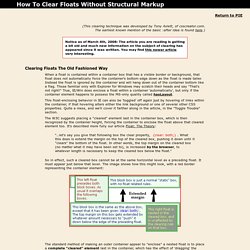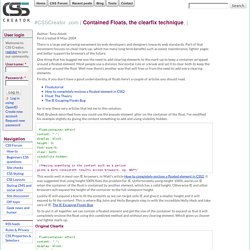

Clearing a float container without source markup. (This clearing technique was developed by Tony Aslett, of csscreator.com.

The earliest known mention of the basic :after idea is found here.) Notice as of March 4th, 2008: The article you are reading is getting a bit old and much new information on the subject of clearing has appeared since it was written. You may find this newer article very interesting. Clearing Floats The Old Fashioned Way When a float is contained within a container box that has a visible border or background, that float does not automatically force the container's bottom edge down as the float is made taller.
This float-enclosing behavior in IE can also be 'toggled' off again just by hovering of links within the container, if that hovering alters either the link background or one of several other CSS properties. The W3C suggests placing a "cleared" element last in the container box, which is then recognized by the container height, forcing the container to enclose the float above that cleared element too. <div><! Step by step CSS float tutorial. Floatutorial takes you through the basics of floating elements such as images, drop caps, next and back buttons, image galleries, inline lists and multi-column layouts.

General info Tutorial 1. Floating an image to the right Float an image to the right of a block of text and apply a border to the image. Tutorial 2. Float an image and caption to the right of a block of text and apply borders using Descendant Selectors. Tutorial 3. Float a series of images down the right side of the page, with content flowing beside them.
Tutorial 4. Float a series of thumbnail images and captions to achieve an image gallery. Tutorial 5. Float a simple list into rollover "back" and next "buttons". Tutorial 6. Float a simple list, converting it into a horizontal navigation bar. Tutorial 7. Float a scaleable drop cap to the left, resize it and adjust line-heights to suit your needs. Tutorial 8. Float a left nav to achieve a two column layout with header and footer. Proprietà css float e clear:spostamenti d’elementi verso la destra o sinistra e rimossione d’elementi floatati di lato a un altro elemento di blocco. Understanding Floats. A mini-tutorial on how the CSS float and clear properties work, and how to use them in your page.

Note: all examples in this tutorial use inline-CSS to illustrate what is going on. You should not do this in your pages, but should instead abstract the styles out into a separate style sheet. For more information, see the "Separate Style from Content" tip in another tutorial of mine, "How to Develop with CSS". What float does The float property causes the item to which it is applied to 'float' to the side of the content which comes after it, with this content wrapping around it.
<p><span style="float:right; background:#ccf">I'm a little floater</span> I'm 'normal' content, and I wrap around any floats which appear before me in source code. I'm a little floater I'm 'normal' content, and I wrap around any floats which appear before me in source code. Note that block-level elements will still wrap around the float: <p style="float:right; background:#ccf; width:10em">I float! Contained Floats, enclosing floats with pure CSS known as the clearfix technique.
Author: Tony Aslett First created 8-May-2004 There is a large and growing movement by web developers and designers towards web standards.

Part of that movement focuses on clean mark-up, which has many long term benefits such as easier maintenance, lighter pages and better support by browsers of the future. One thing that has bugged me was the need to add clearing elements to the mark-up to keep a container wrapped around a floated element. Most people use a division, horizontal rule or a break and set it to clear both to keep the container around the float.
Well now there's another way that will free us from the need to add extra clearing elements. Firstly, if you don't have a good understanding of floats here's a couple of articles you should read. for it was these very articles that led me to this solution. Matt Brubeck described how you could use the pseudo element :after on the container of the float. Original Clearfix Micro Clearfix Combinator Clearfix Updates Author: Tony Aslett.